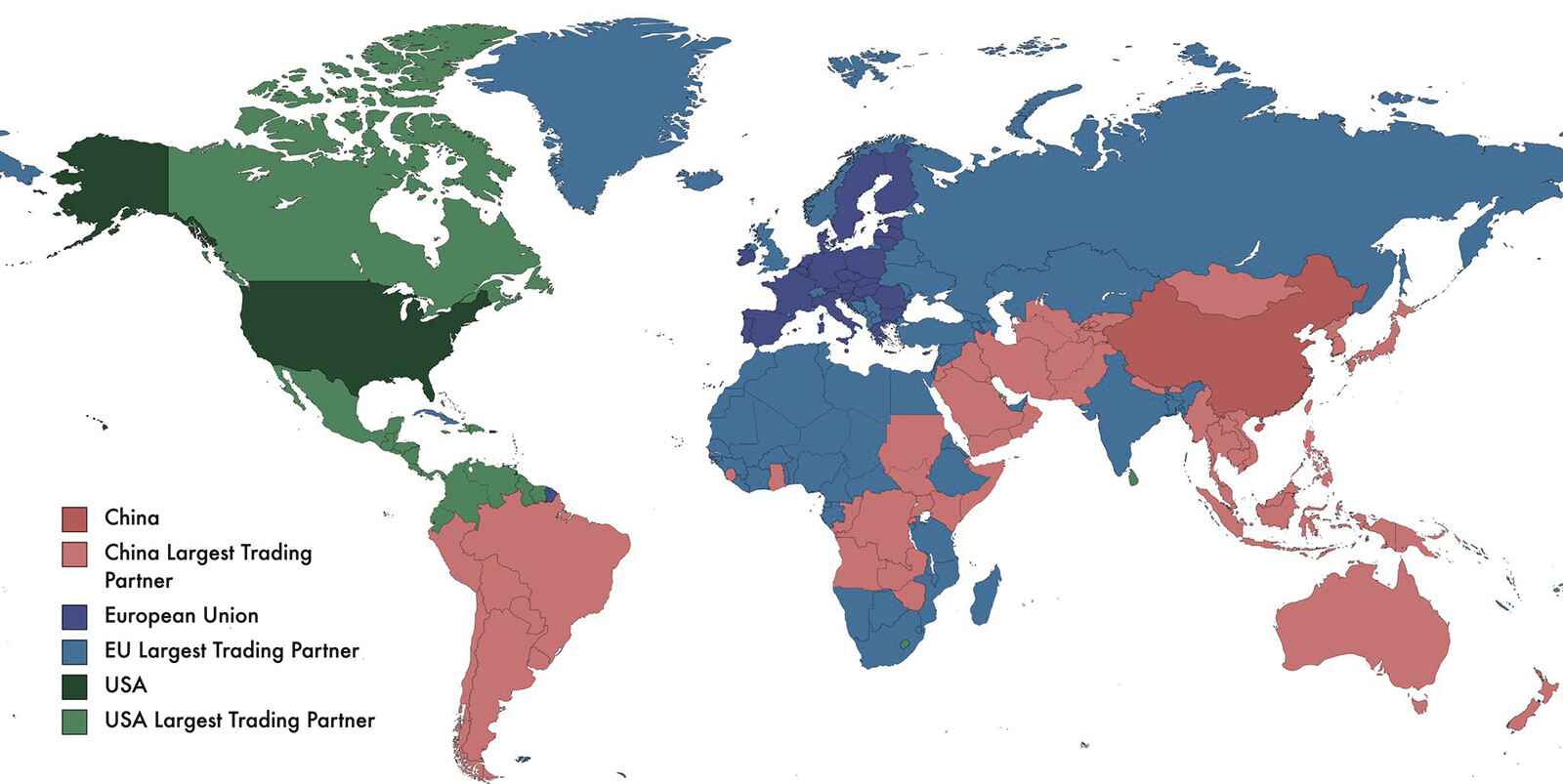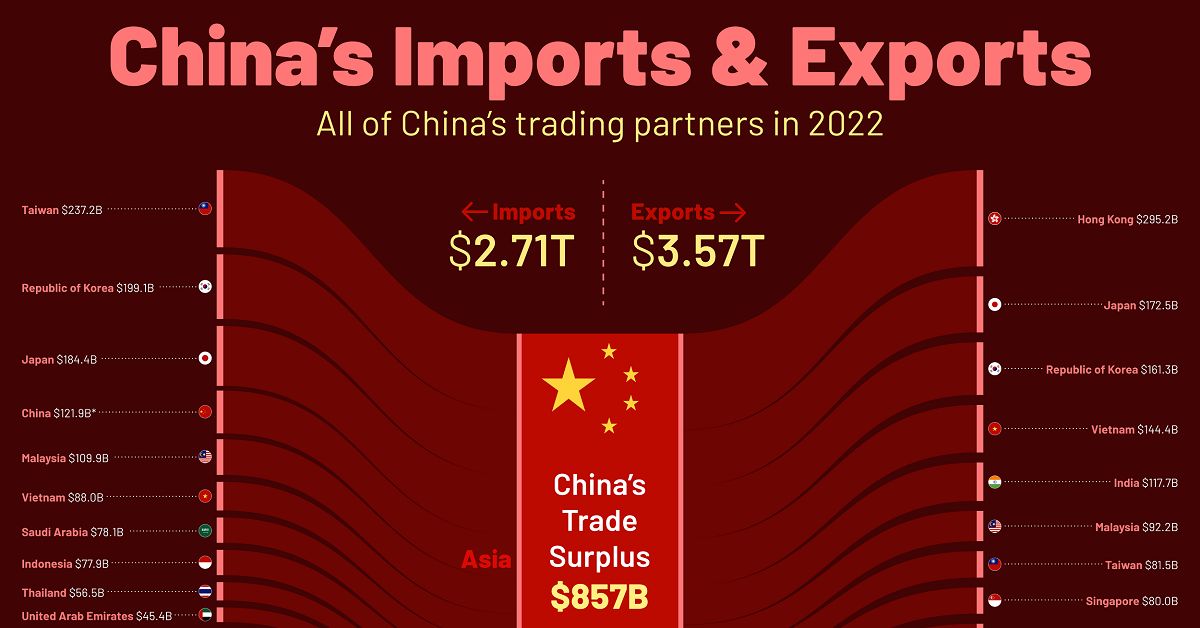Introduction
China, with its vast population and rapidly growing economy, has emerged as a global powerhouse in the realm of international trade. As the world’s second-largest economy, China plays a pivotal role in shaping the global trade landscape. Its tremendous manufacturing capabilities, abundant labor force, and strategic geographical location have made it an attractive destination for multinational corporations seeking to tap into its massive market and leverage its competitive advantages.
In recent years, China has experienced unprecedented growth in both imports and exports, making it a key player in global trade. The country’s successful economic policies, infrastructure development, and integration into the global supply chain have allowed it to become a major trading hub. China’s trading partners, therefore, hold great significance in determining its economic success and shaping its international relationships.
Understanding China’s key trading partners is crucial for comprehending the dynamics of global trade and its impact on the Chinese economy. This article seeks to explore the factors influencing China’s trading relationships and provide an overview of its largest trading partners.
By analyzing China’s trade relationships with major economies such as the United States, the European Union, ASEAN countries, and Japan, we can gain insights into the intricate web of global trade and the interplay between economic powerhouses. Through this exploration, we can also assess the implications of these trading relationships on geopolitical dynamics and the future direction of global commerce.
Explaining China’s Importance in Global Trade
China’s rise as a key player in global trade can be attributed to several factors. Firstly, China has a massive consumer market fueled by its population of over 1.4 billion people. This vast domestic market provides a strong foundation for the production and consumption of goods, attracting foreign companies to establish a presence in China to meet the growing demand.
Secondly, China’s low-cost manufacturing capabilities have significantly contributed to its dominance in global trade. The country is known for its efficient production processes and competitive labor costs, making it an attractive manufacturing hub. This has allowed Chinese companies to produce goods at lower prices, leading to increased exports and a significant share of the global market.
Moreover, China’s strategic geographical location provides it with access to various transportation routes and shipping lanes. This facilitates the smooth movement of goods between China and its trading partners, enhancing its connectivity and enabling efficient supply chain management.
China’s government policies have also played a vital role in promoting its position in global trade. The government’s emphasis on export-led growth and its support for infrastructure development have facilitated the expansion of China’s trade volume. Measures such as the establishment of special economic zones and the implementation of foreign investment policies have attracted foreign investment, leading to further growth in international trade.
The country’s membership in international trade organizations such as the World Trade Organization (WTO) has also contributed to its importance in global trade. China’s active participation in multilateral trade negotiations and its commitment to reducing trade barriers have fostered an environment conducive to international trade and cooperation.
Overall, China’s significance in global trade cannot be overstated. Its massive domestic market, cost-effective manufacturing capabilities, strategic location, government policies, and involvement in international trade organizations have positioned it as a major player and have reshaped the global trade landscape.
Factors Influencing China’s Trading Partners
The selection of trading partners for any country is influenced by a multitude of factors, and China is no exception. Several key factors shape China’s trading relationships with other nations.
One significant factor is market demand. China’s immense population and growing middle class create a massive consumer market that is highly attractive to countries seeking to export their goods and services. The sheer size of China’s market presents a significant opportunity for trading partners to expand their sales and increase their revenues.
Another factor is China’s competitive manufacturing sector. Chinese factories are known for their efficiency, technological advancements, and cost-effectiveness. This makes China an attractive destination for companies seeking to lower their production costs or outsource their manufacturing operations. Trading partners can take advantage of China’s manufacturing capabilities by establishing production facilities or sourcing products from Chinese suppliers.
The geographical proximity of countries also plays a role in determining trading partners. Neighboring countries, such as those in Southeast Asia or Japan, have natural trade advantages with China due to their close proximity. This proximity facilitates the transportation of goods, reduces logistical costs, and promotes stronger economic ties between the countries.
Government policies and trade agreements also shape China’s trading partners. Bilateral and multilateral trade agreements, such as free trade agreements or preferential trade arrangements, can incentivize countries to strengthen their trade relationships with China. These agreements reduce trade barriers, facilitate market access, and create a more predictable and favorable business environment for trading partners.
Political and diplomatic relations also influence China’s trading partners. Countries with strong bilateral ties and favorable political relationships with China are more likely to engage in robust trade. Diplomatic initiatives, such as high-level visits, trade missions, and diplomatic agreements, can further enhance trade cooperation between countries.
Lastly, supply chain integration also plays a significant role in determining China’s trading partners. Global companies often have complex supply chains that span multiple countries. China’s role as a manufacturing and sourcing hub makes it an integral part of many supply chains. Trading partners with close supply chain integration, where components or raw materials are sourced from China, are more likely to engage in substantial trade activities.
These factors, including market demand, manufacturing capabilities, geographical proximity, government policies, political relations, and supply chain integration, collectively influence China’s choice of trading partners. Understanding these factors helps explain the intricate web of China’s trading relationships and the dynamics of global trade.
Overview of China’s Top Trading Partners
China’s economic influence extends to a wide array of countries across the globe. As a major global trader, China has cultivated strong trading partnerships with numerous nations. Let’s take a look at an overview of China’s top trading partners.
The United States, as the world’s largest economy, holds a significant position in China’s trade landscape. Despite occasional trade tensions and disputes, the US remains one of China’s most important trading partners. Bilateral trade between the two countries involves a wide range of products, including technology, machinery, and consumer goods.
The European Union (EU) also occupies a prominent spot on China’s list of trading partners. The EU and China engage in substantial trade in various sectors, such as electronics, automobiles, and chemicals. China’s exports to the EU consist primarily of machinery, textiles, and furniture, while its imports include automobiles, pharmaceuticals, and aircraft.
China’s proximity to East and Southeast Asia has led to robust trading relationships with countries in the ASEAN region. ASEAN countries, including Thailand, Vietnam, and Malaysia, are major trading partners for China. China exports a wide range of products to ASEAN, including electrical machinery, vehicles, and plastics, while importing commodities like natural resources, agricultural products, and minerals.
Another significant trading partner for China is Japan. Although historical tensions between the two nations have influenced their trade relations, Japan remains an important partner for China. Trade between the two countries primarily revolves around machinery, electronics, automobiles, and high-tech products.
In recent years, China has also cultivated trading partnerships with other emerging economies, including Brazil and Russia. These countries supply China with commodities such as oil, gas, and agricultural products, while China exports electronics, machinery, and manufactured goods in return.
China’s trading relationships extend beyond these key partners to encompass countries across Africa, the Middle East, and Latin America. As China’s Belt and Road Initiative continues to progress, trade ties with countries along the initiative’s routes are expected to further strengthen.
These are just a few examples of China’s top trading partners, representing different regions and industries. China’s extensive network of trading relationships underscores its global economic reach and highlights its role as a critical player in the international trade arena.
Ranking China’s Largest Trading Partners
China’s economic prowess and global trade dominance have propelled it to establish strong trading partnerships with countries around the world. Let’s delve into ranking China’s largest trading partners based on the volume of trade and their economic ties with China.
At the top of the list is the United States. Despite intermittent trade tensions, the US has consistently been China’s largest trading partner. The bilateral trade between these two economic giants covers a broad range of sectors, including technology, machinery, and consumer goods. However, fluctuations in political relations and policy changes can influence the trading relationship between the two countries over time.
The European Union (EU) holds a significant position as one of China’s largest trading partners. The EU and China engage in substantial trade across various sectors, such as electronics, automobiles, and chemicals. The EU is both a significant market for Chinese exports and a key source of imports for China, making it a critical trade partner.
Within East and Southeast Asia, the Association of Southeast Asian Nations (ASEAN) collectively represents a significant trading partner for China. ASEAN countries, including Thailand, Vietnam, and Malaysia, have established close economic ties with China, with trade spanning various industries. The ASEAN region is an important destination for Chinese exports, while providing China with crucial commodities and raw materials.
Japan is also a noteworthy trading partner for China, despite historical tensions between the two countries. Trade between China and Japan revolves around machinery, electronics, automobiles, and high-tech products. Both countries have made efforts to strengthen economic cooperation and foster better trade relations.
Other major trading partners for China include countries in Latin America, Africa, and the Middle East. Brazil, with its rich natural resources, trades commodities such as soybeans, iron ore, and oil with China. Russia is another key partner, primarily supplying China with commodities such as oil, gas, and agricultural products.
China’s ranking of trading partners is dynamic and subject to market fluctuations, political developments, and shifting economic trends. Emerging economies and countries participating in China’s Belt and Road Initiative are poised to see increased trade volumes with China as infrastructure development and connectivity are enhanced.
It is important to note that while some countries may rank lower in terms of overall trade volume, they may still play crucial roles in specific industries or sectors for China. The ranking of China’s largest trading partners is multifaceted, reflecting the diverse nature of China’s global trade relationships.
Analysis of China’s Trade Relationship with the United States
The trade relationship between China and the United States is a complex and multifaceted one, influenced by various economic, political, and social factors. Let’s delve into an analysis of this crucial trade relationship.
China and the United States have long been major trading partners, with bilateral trade volume reaching high levels over the years. Both countries have mutually benefited from this trade relationship, with China serving as a key exporter of goods to the US market, while the US provides China with a significant market for its products.
However, tensions and disputes have emerged, leading to fluctuations and uncertainties in this trade relationship. In recent years, trade imbalances and intellectual property concerns have been central issues of contention between the two nations.
The US has expressed concerns over its trade deficit with China, highlighting China’s high exports to the US compared to its imports from the US. This trade imbalance has led to accusations of unfair trade practices and currency manipulation by China, contributing to trade friction between the two countries.
The issue of intellectual property rights has also been a significant point of conflict. The US has asserted that China engages in intellectual property theft and forced technology transfers, impacting American businesses and hindering fair competition. These concerns have led to the imposition of tariffs and trade restrictions on certain Chinese goods by the US government.
Despite the challenges and disputes, both countries have shown a willingness to engage in dialogue and negotiations to address their trade issues. High-level trade talks and negotiations have taken place to find common ground and work towards a more balanced and mutually beneficial trade relationship.
It is important to note that the trade relationship between China and the US extends beyond just goods. Services trade, such as finance, technology, and tourism, also plays a significant role in the overall trade relationship. Both countries have a strong presence in each other’s service sectors, facilitating economic cooperation and exchange.
The ongoing trade relationship between China and the US is of great importance, given their significant economic influence and global standing. The outcome of their trade negotiations and policies will not only impact their own economies but will also reverberate throughout the global trade landscape.
It is essential for both countries to strive for open and fair trade practices, foster better market access, protect intellectual property rights, and address trade imbalances through dialogue and negotiation. A stable and mutually beneficial trade relationship between China and the US has the potential to contribute to global economic growth and stability.
Examination of China’s Trade Relationship with the European Union
The trade relationship between China and the European Union (EU) is a vital aspect of each party’s global trade strategy. This section focuses on examining the trade relationship between China and the EU, highlighting its significance and key dynamics.
The EU represents one of China’s largest trading partners, and bilateral trade between the two has been growing steadily over the years. The trade relationship covers a wide range of sectors, including electronics, automobiles, machinery, and chemicals.
China has been a major exporter to the EU, supplying it with various manufactured goods such as textiles, furniture, and machinery. On the other hand, the EU provides China with a substantial market for its exports, including automobiles, pharmaceuticals, and aircraft.
Market demand, economic complementarity, and supply chain integration have played crucial roles in fostering strong trade ties between China and the EU. The EU market offers a significant opportunity for Chinese businesses seeking to expand their sales and tap into a consumer base with substantial purchasing power.
Moreover, the EU’s advanced technologies and high-quality products are in demand in the Chinese market. The trade relationship has facilitated technology transfers and knowledge sharing, enabling innovation and development in both economies.
However, the trade relationship between China and the EU is not without challenges. Issues related to market access, intellectual property rights, and transparency remain points of contention. Both sides have engaged in dialogues and negotiations to address these concerns and create a more level playing field for businesses.
Trade disputes and tariff tensions have emerged at times, impacting the trade relationship. The EU has imposed anti-dumping duties on specific Chinese products, while China has responded with countermeasures. Nevertheless, overall trade volumes have remained robust, indicating the resilience of the trade relationship.
The strategic partnership between China and the EU extends beyond just trade. Collaborative initiatives in research and development, infrastructure projects, and climate change have brought the relationship to a deeper level. The EU and China have jointly worked on initiatives such as China’s Belt and Road Initiative, promoting connectivity and economic cooperation.
As both China and the EU navigate their respective economic and political landscapes, the trade relationship between the two will continue to evolve. Addressing concerns related to market access, intellectual property rights, and creating a more transparent and fair trade environment will be vital in fostering a strong and sustainable trade relationship.
The trade relationship between China and the EU is a crucial component of the global trade landscape. Strengthening economic cooperation, boosting trade volumes, and resolving key issues will contribute to mutual benefits, economic growth, and stability for both parties.
Exploring China’s Trade Ties with ASEAN Countries
The trade relationship between China and the Association of Southeast Asian Nations (ASEAN) has witnessed significant growth and cooperation in recent years. This section delves into exploring the trade ties between China and ASEAN countries, highlighting their importance and key dynamics.
ASEAN countries, including Thailand, Vietnam, Malaysia, and Indonesia, among others, hold critical positions as trading partners for China. Trade volumes between China and ASEAN have been steadily increasing, driven by various factors and complementarities.
China exports a wide range of products to ASEAN, including electrical machinery, vehicles, and plastics. In return, China imports commodities such as natural resources, agricultural products, and minerals from ASEAN countries. This trade relationship allows both sides to leverage their respective strengths and resources.
Geographical proximity plays a vital role in fostering trade ties between China and ASEAN. Their shared border and close proximity facilitate the transportation of goods, resulting in reduced logistical costs and smoother trade facilitation.
Affordable labor costs in ASEAN countries have attracted Chinese companies to establish production facilities in the region. This has resulted in increased intra-regional trade and investment, strengthening the economic ties between China and ASEAN.
ASEAN serves as an essential market for Chinese exports, as the region has a growing middle class with increased purchasing power. Chinese products, ranging from electronics to consumer goods, are in high demand among ASEAN consumers, presenting lucrative opportunities for Chinese businesses.
The ASEAN-China Free Trade Area (ACFTA) has played a significant role in facilitating trade between China and ASEAN. The ACFTA, which has been progressively implemented since 2003, has eliminated or reduced tariffs on numerous products, creating a more favorable trade environment for both sides.
Furthermore, initiatives such as the Belt and Road Initiative (BRI) have contributed to enhancing trade ties between China and ASEAN. The BRI aims to promote infrastructure connectivity, economic cooperation, and people-to-people exchanges across the region, providing new trade opportunities and fostering closer collaboration.
Challenges persist in the China-ASEAN trade relationship, including issues related to trade imbalances, market access, and intellectual property rights. However, both sides have shown a commitment to addressing these challenges through bilateral and multilateral dialogues.
As ASEAN countries continue to grow and develop, their trade ties with China are expected to expand further. Closer collaboration in sectors such as technology, digital economy, and innovation presents new avenues for trade and economic cooperation.
Exploring and nurturing trade ties with ASEAN countries is strategically important for China, given the economic potential of the region and its position as a gateway to other emerging markets. By strengthening trade ties with ASEAN, China can tap into new markets and foster mutually beneficial economic relationships.
Assessing China’s Trade Links with Japan
The trade relationship between China and Japan is of great significance, considering their geographic proximity and economic prowess. This section assesses the trade links between China and Japan, exploring their key dynamics and implications.
China and Japan have a long history of economic interdependence and trade. Both countries are major global economies and prominent trading partners in the Asia-Pacific region.
Trade between China and Japan encompasses a wide range of industries, including machinery, electronics, automobiles, and high-tech products. China exports a variety of goods to Japan, such as textiles, machinery, and electrical equipment, while Japan supplies China with automobiles, chemicals, and industrial machinery.
Political tensions and historical disputes have, at times, affected the trade relationship between China and Japan. However, both countries recognize the importance of economic cooperation and have made efforts to enhance trade ties.
Geographical proximity has facilitated trade links between China and Japan, enabling efficient transportation of goods and reducing logistical costs. The increasing connectivity in the region through infrastructure projects and transportation networks has further strengthened trade ties.
Additionally, the presence of global supply chains and multinational corporations has fostered closer economic cooperation between China and Japan. Many Japanese companies have established production facilities and supply chains in China, capitalizing on China’s manufacturing capabilities and vast consumer market.
Bilateral trade agreements and economic cooperation initiatives have also contributed to the growth of trade between China and Japan. Both countries have participated in dialogues and negotiations to address trade barriers, promote investment, and explore opportunities for collaboration in various industries.
The Chinese market is especially attractive to Japanese businesses due to its size and growing middle class. China’s rising consumer purchasing power presents significant opportunities for Japanese companies to expand their market share and increase exports.
Despite occasional trade frictions and political disputes, both China and Japan recognize the mutual benefits of maintaining a stable and robust trade relationship. Both countries have a vested interest in promoting trade liberalization and fostering an environment that facilitates bilateral trade and investment.
Furthermore, people-to-people exchanges between China and Japan contribute to the trade relationship. Tourism, cultural exchanges, and educational collaborations between the two countries create avenues for deeper understanding and stronger ties.
While challenges exist, including competition in certain industries and intellectual property concerns, the trade links between China and Japan continue to grow and evolve. The ongoing collaboration and trade cooperation between these economic powerhouses contribute not only to their individual economic growth but also to regional and global trade stability.
By nurturing trade links and promoting closer economic cooperation, China and Japan can harness the potential for mutual prosperity, innovation, and sustainable development.
Conclusion
In conclusion, China’s role in global trade cannot be underestimated. Its immense market, competitive manufacturing capabilities, strategic geographical location, and government policies have positioned it as a major player in international trade.
China has established strong trade ties with various countries and regions around the world. The United States, the European Union, ASEAN countries, and Japan are among its key trading partners.
The trade relationships between China and these partners are influenced by factors such as market demand, manufacturing strengths, geographical proximity, government policies, political relations, and supply chain integration.
While challenges and disputes may arise, such as trade imbalances, intellectual property concerns, and political tensions, dialogue and negotiations are essential for addressing these issues and fostering fair and mutually beneficial trade relationships.
The trade relationships between China and its partners extend beyond the exchange of goods to encompass services trade, collaborative projects, and cultural exchanges, contributing to a deeper and more comprehensive economic cooperation.
Looking ahead, China’s trade ties will continue to evolve and adapt to changing economic landscapes and global dynamics. As China further integrates into the global economy and strengthens its partnerships, it will play a crucial role in shaping the future of international trade.
By promoting open and fair trade practices, addressing trade barriers, and fostering deeper economic cooperation, China can continue to contribute to global economic growth and stability.
The intricate web of China’s trading relationships highlights the interconnectedness of the global trade landscape. Understanding and analyzing these relationships provide valuable insights into the dynamics and trends of international trade in the 21st century.

























